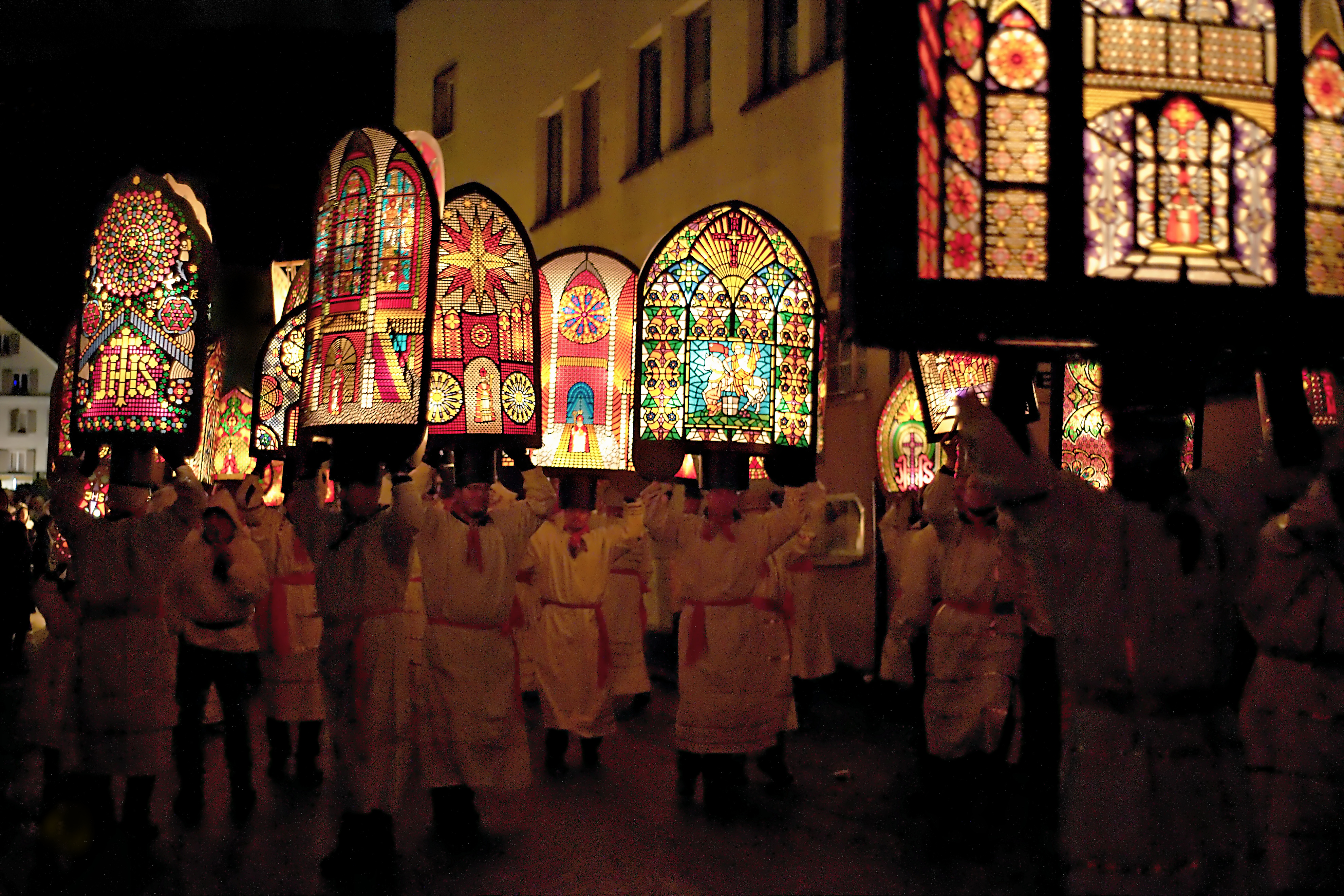Klausjagen on:
[Wikipedia]
[Google]
[Amazon]
 The Klausjagen ("
The Klausjagen ("
Klausjagen homepage-history
accessed 13 December 2016 In the 1920s, the still rather rough procession was tamed by a committee of villagers who created the modern, clearly organized parade. Since 1928, the St. Nicholas Society of Küssnacht has been responsible for the continuation of the custom. The procession is organised in six stages. First come men cracking long two-handed sheep whips. Next come men wearing Iffelen or Infuln, which are enormous, incredibly ornate paper hats which resemble a cross between a bishop's mitre and a stained glass window, lit from the inside by candles, and as much as seven feet tall. Behind them is St. Nicholas himself, with four attendants in black robes and hoods known as Schmutzlis, who hand out pastries. After them comes a brass band playing the traditional Klaus song, followed by a large group ringing trycheln, large bells which are descendants of cow bells. Lastly, the entire procession is followed by men blowing cow horns. Participants and watchers then generally head on to celebrations in local taverns.
1997 Pulse of the Planet article
Swiss folklore Küssnacht Tourist attractions in the canton of Schwyz Festivals in Switzerland 1732 disestablishments Festivals established in 1928 Parades in Switzerland Winter events in Switzerland
 The Klausjagen ("
The Klausjagen ("Nicholas
Nicholas is a male given name and a surname.
The Eastern Orthodox Church, the Roman Catholic Church, and the Anglicanism, Anglican Churches celebrate Saint Nicholas every year on December 6, which is the name day for "Nicholas". In Greece, the n ...
chase") festival takes place in the Swiss town of Küssnacht
Küssnacht am Rigi (official name since 2004: Küssnacht) is a village and a district and a municipality in the canton of Schwyz in Switzerland. The municipality consists of three villages Küssnacht, Immensee, and Merlischachen, the hamlet ''Ha ...
on the eve of St. Nicholas Day
Saint Nicholas Day, also called the Feast of Saint Nicholas, observed on 5 December or on 6 December in Western Christian countries, and on 19 December in Eastern Christian countries using the old church Calendar, is the feast day of Saint Nic ...
. The festival, attended each year by about 20,000 people, consists of a parade of around 1,500 participants, and lasts far into the night.
History
The procession is believed to have its roots in pre-Christian pagan traditions involving the chasing of wild spirits (compareWild Hunt
The Wild Hunt is a folklore motif (Motif E501 in Stith Thompson's Motif-Index of Folk-Literature) that occurs in the folklore of various northern European cultures. Wild Hunts typically involve a chase led by a mythological figure escorted by ...
). The early forms of the Klausjagen involved much unruliness and noise, and were frowned upon by Church and authorities, and were officially outlawed in 1732, but could not be effectively suppressed. In the late 19th century, the custom was instead "Christianized" and bishop's mitres first appeared in the procession.accessed 13 December 2016 In the 1920s, the still rather rough procession was tamed by a committee of villagers who created the modern, clearly organized parade. Since 1928, the St. Nicholas Society of Küssnacht has been responsible for the continuation of the custom. The procession is organised in six stages. First come men cracking long two-handed sheep whips. Next come men wearing Iffelen or Infuln, which are enormous, incredibly ornate paper hats which resemble a cross between a bishop's mitre and a stained glass window, lit from the inside by candles, and as much as seven feet tall. Behind them is St. Nicholas himself, with four attendants in black robes and hoods known as Schmutzlis, who hand out pastries. After them comes a brass band playing the traditional Klaus song, followed by a large group ringing trycheln, large bells which are descendants of cow bells. Lastly, the entire procession is followed by men blowing cow horns. Participants and watchers then generally head on to celebrations in local taverns.
References
{{reflistExternal links
* http://www.klausjagen.ch/ - The official Klausjagen homepage.1997 Pulse of the Planet article
Swiss folklore Küssnacht Tourist attractions in the canton of Schwyz Festivals in Switzerland 1732 disestablishments Festivals established in 1928 Parades in Switzerland Winter events in Switzerland